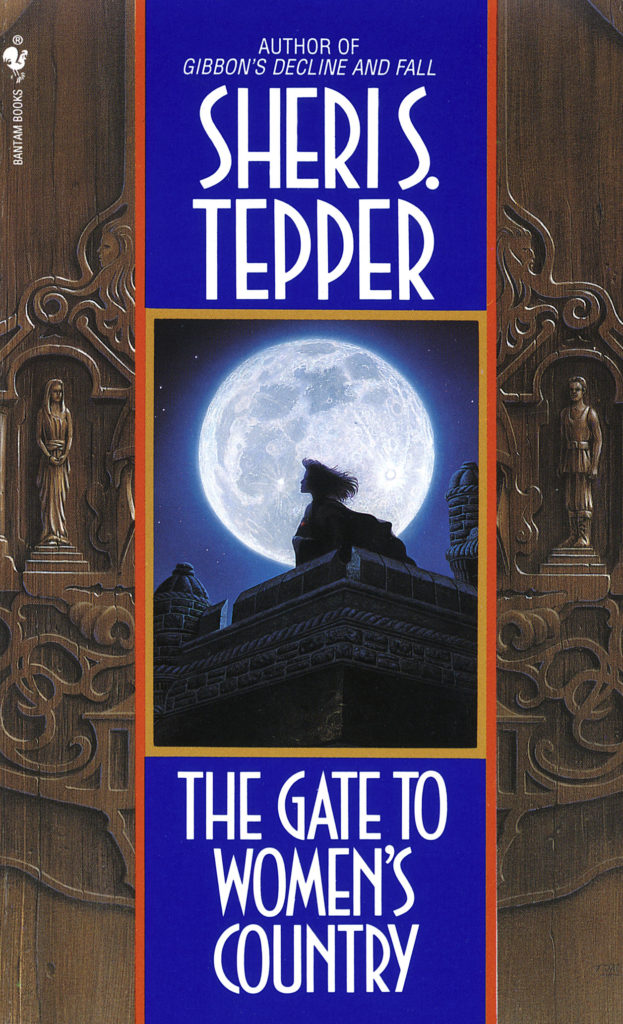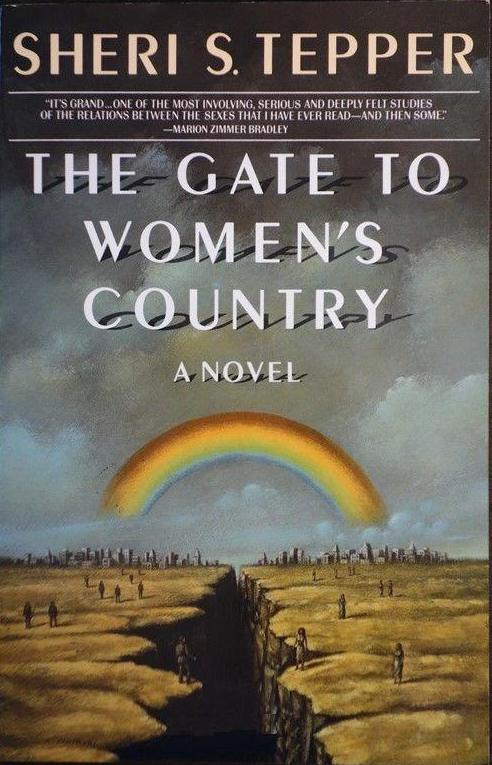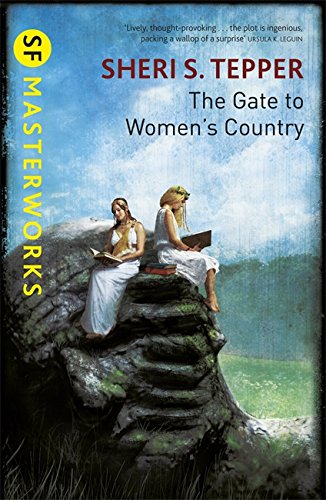This Month On Changing the Map
Last October, I woke to the news that much-loved feminist spec fic author Sheri S. Tepper had died. It hit me hard, not because her death was untimely (87? Hardly.), but because at one time she’d been my favorite author but I didn’t even know she was still alive.
How could I lose track of an author who meant so much to me?
Simple. Because at some point, I felt I didn’t need to read feminist fiction anymore. I’d absorbed the ideas, they informed me and changed me, and anyway, wasn’t the world getting better? Weren’t we, if not perfectly equal, awfully close to it? Wasn’t it just a question of time?
Sadly, we’re discovering that we haven’t won that fight. The legal protections and social justice our mothers and grandmothers fought for can be turned back or obliterated with the stroke of a pen.
We still need feminist fiction. But why do we need speculative feminist fiction, the kind of kind of stories Tepper wrote, alongside her peers Le Guin, Butler, and Atwood?
We need it because speculative fiction is, at its heart, a “what if?” notion. What if women had the power? What if they made the decisions? How much better might “what if?” be from “what is?”
“What if” is at the heart of Tepper’s speculative feminist classic, The Gate to Women’s Country. In it, she asks this question: if the true root of gender inequality is hardwired, a function of sexual violence and aggression tied to male biology, what if we could change the biology?
About the Author
 Sheri S. Tepper was born in 1929 in rural Colorado. Raised in a house full of elderly relatives, she and her brother James spent most of their childhood outdoors, and it’s this love of animals and the environment that informed much of her work, often described as “eco-feminism.” For most of her adult life, she worked for Planned Parenthood of Denver, where she fought tirelessly for affordable family planning and reproductive rights. She didn’t start writing until her retirement. The Gate to Women’s Country, arguably her most famous novel, was first published when she was 59.
Sheri S. Tepper was born in 1929 in rural Colorado. Raised in a house full of elderly relatives, she and her brother James spent most of their childhood outdoors, and it’s this love of animals and the environment that informed much of her work, often described as “eco-feminism.” For most of her adult life, she worked for Planned Parenthood of Denver, where she fought tirelessly for affordable family planning and reproductive rights. She didn’t start writing until her retirement. The Gate to Women’s Country, arguably her most famous novel, was first published when she was 59.
 The Gate to Women’s Country (1988)
The Gate to Women’s Country (1988)
Written by: Sheri S. Tepper
Genre: Science Fiction
Pages: 315 (Mass Market Paperback)
Publisher: Bantam Spectra
Spoilers: Everything including the ending.
Discussion: The Gate to Women’s Country opens in Marthatown, a small walled city somewhere in the Pacific Northwest. Three-hundred years after nuclear war nearly destroyed the human race, Marthatown and its sister towns have formed a network of trade and cooperation to guarantee their survival. Most animal and plant species were destroyed by the wars and the women of the towns work hard to discover and protect what species remain. Ostensibly for their protection, the men now live outside of the walls, in warrior communities known as garrisons. The garrisons train the warriors and protect the towns from invasion.
The story opens with protagonist Stavia, the mother of a young warrior, performing a painful ritual. In this world, sons are given over to their warrior-father’s care at the age of 5. At the age of 15, they can choose to stay with their fathers and become true Defenders, or return through the Gate to Women’s County, a door in the side of the city’s wall. Young soldiers who return are expected to become servitors — gentle guardians and help-mates to the city’s women. To turn their back on warrior life is considered shameful and baby-like — titsuckers, according to their former comrades. Stavia’s son Dawid chooses to stay with the men and continue his warrior training. She’s saddened, but not surprised.
It’s this loss of her son that gives the plot its structure. As she tries to go on with her day, practicing for her part in a play based on “The Trojan Women,” Stavia finds herself unable to stop thinking about the events that brought her to this moment and to the conception of her son. For some readers (and for me, on first read), the play as leitmotif and through-plot can be offputting. We get the play in scenes throughout the novel, and at times these asides feel distracting and far too easy to skim. But a close reading of the play does pay off in the end.
As she rehearses, Stavia flashes back to the first time she met her son’s father, Chernon, a young warrior at the garrison. He was thirteen; Stavia only ten. Though she’s fascinated by Chernon, practical, unromantic Stavia has no interest in boys. She’s watched her sister Myra’s infatuation with warriors in general, and one in particular, and Stavia vows never to be that weak or insipid.
The older Myra is now of age, and planning an “assignation” with a soldier during one of the twice-yearly Carnivals. During Carnival, the men from the garrison can visit the city, feast and drink, reunite with their family, and meet with their sweethearts, or any willing female, in one of the city’s Assignation Houses. This is how children are conceived in a world where most of the men and women are separated by a wall. Stavia, who accompanies her Councilwoman mother on medical inspections, finds the reality of infatuation a bit too depressing to romanticize.
“Infatuation makes otherwise reasonable women behave in unreasonable and illogical ways. It is a result of biological forces incident to racial survival.” (pg. 41)
But knowing that these impulses are a function of hormones and being able to avoid infatuation herself are two different things. When she meets Chernon again a year later, she begins to waver.
“Her insides did not feel at all practical. They felt liquefied. It was a strange, almost indecent feeling and she did not want to deal with it, or even consider it.” (pg. 64)
Stavia tries to avoid him, but Chernon persists. He’s been tasked by the Garrison’s commanders to seduce Stavia. Their mother is a Councilwoman, and the commanders suspect that the women who run Women’s Country are hiding weapons and scientific discoveries. An adult councilwoman would never tell them the truth, but their young, impressionable daughters might. The warriors want to take back the towns from the women. THEY want to run everything, and they need information from the inside in order to do it.
“Why do we put up with them?” Stephen’s lips twisted in a grimace of distaste as he sneered, “Stupid baaing ewe sheep! Why don’t we just take over the city? We could. Any garrison could. Why don’t we?” (pg. 66)
Despite Stavia’s convictions about romance, Chernon finds a way to suck her in. He begs her to bring him books. The warriors only have books about battle and armor, nothing about science or engineering or metallurgy. Stavia, a scholar herself, feels his pain. She begins to sneak him books, breaking the strict ordinances of Women’s Country in the process. Chernon believes he can find something of value to the commanders in the books and also entrap Stavia’s feelings at the same time.
 Stavia is torn between her affection for Chernon and what she knows is right. In the end it is their family servitor, Joshua, who senses Stavia’s agony and arranges for her to be sent away to begin her medical training in another town, far from Chernon.
Stavia is torn between her affection for Chernon and what she knows is right. In the end it is their family servitor, Joshua, who senses Stavia’s agony and arranges for her to be sent away to begin her medical training in another town, far from Chernon.
Nine years later, Stavia is a doctor, and newly returned to Marthatown. But time hasn’t made her any less susceptible to Chernon’s pleas, and the commanders are no less interested in taking over Women’s Country. Her mother encourages her to go on a medical and scientific exploration of the lands to the south, and Stavia agrees. But she’s also secretly decided to ditch her traveling companion in favor of Chernon, who has dreamed of getting Stavia alone to himself.
When they meet outside the town, reality collides with fantasy. Chernon wordlessly forces himself on her. “If it had not been precisely rape, it had been close to it” (pg. 237). But Stavia tries to make the best of it, telling herself that what she needs to do is instruct Chernon. They become lovers, but quickly Stavia realizes Chernon’s true nature and she wants to go back to Marthatown. But before she can leave him, they’re both captured by the Holylanders — a mad religious sect that lives outside of the control of Women’s Country. Stavia is eventually rescued, and both she and Chernon return to Women’s Country.
But Stavia’s returned with something more than just bad memories. She’s pregnant by Chernon, and the pregnancy opens her up to the real scientific secrets of Women’s Country. Having long ago decided that the root cause of the nuclear devastation was male aggression, those in charge of Women’s Country have been actively breeding it out of the population. The men who come back through the gate — the “titsuckers” who would rather work alongside the women instead of fighting wars — are the true progenitors of every child born in the cities. None of the warriors are actually the fathers of their children. And the more the women breed with the gentler servitors, the more young men come back through the gate, choosing to be helpmates instead of controlling husbands. Through this method, the women will be able to breed out the aggressive genes, and give humanity a chance to avoid destroying itself in the future.
How it Changed The Map
Tepper isn’t the first speculative fiction writer to use science as a way to solve gender inequity, but she was the first to use selective breeding as a plot device for creating a female utopia. And like other writers of the feminist Second Wave, she didn’t hesitate to lay the blame for some of these problems on women, as well.
 In Myra’s obsession with romance, and also in Stavia’s struggles with Chernon, we see how infatuation and female biology can make women act against their own self-interest. Aggressive men aren’t the only impediment to a society of equality. Foolish women are too. Both need to be bred out of the gene pool if disaster is going to be avoided again.
In Myra’s obsession with romance, and also in Stavia’s struggles with Chernon, we see how infatuation and female biology can make women act against their own self-interest. Aggressive men aren’t the only impediment to a society of equality. Foolish women are too. Both need to be bred out of the gene pool if disaster is going to be avoided again.
Tepper has one notable misstep in her imagining of a perfect future. She tells us the doctors of Women’s Country discovered that homosexuality was found to be a shortage of a hormone, a kind of birth defect, and it’s been “fixed.” The idea is only mentioned once, so as a reader I’m hard-pressed to view this as a homophobic agenda based on this book alone. The mention does, however, sadden and detract from an otherwise fantastic story.
In this novel, we see the confluence of Tepper’s interest in animals and biology, along with what she no doubt observed in her time at Planned Parenthood. Men can be too aggressive, women too gullible, and that combination keeps producing more babies with the same behaviors.
So is Tepper’s premise that we would all benefit from a future that included eugenics? It certainly seems to be. Does that render the story distasteful or lacking in merit? What if it’s the only way to stop war, aggression, and destruction? I suppose it comes down to whether you think the ends justify the means. You should read the story and decide for yourself.
Next Month: We revisit Justine Larbalestier’s feminist spec fic anthology, Daughters of Earth, to take a look at some fantastic Second Wave short stories.

I am realizing that somehow I’ve never read Tepper. This is kind of appalling, I think. I will have to remedy this.
Grass is fantastic, too!!!
You know, I’m still stuck in the beginning of Grass. That hunting scene…. gah!
I do think it’s problematic in places, but I felt like she was hitting her anthropological SF stride.
I’ve read exactly one of Tepper’s books–The Companions, where one of the themes is the human race needing to be able to co-exist with itself before it can try co-existing with everyone else. I almost didn’t feel smart enough to read it–but I was left with a sense of epic, sweeping awesomeness. I want to read more of her books, especially The Gate to Women’s Country, and Grass.
I never read that one!!! How did it slip by me? Thanks for the recommendation.